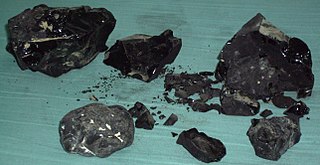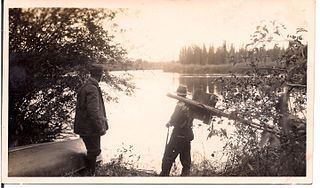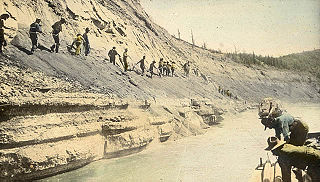Related Research Articles

Asphalt, also known as bitumen, is a sticky, black, highly viscous liquid or semi-solid form of petroleum. It may be found in natural deposits or may be a refined product, and is classed as a pitch. Before the 20th century, the term asphaltum was also used. The word is derived from the Ancient Greek ἄσφαλτος ásphaltos. The largest natural deposit of asphalt in the world, estimated to contain 10 million tons, is the Pitch Lake located in La Brea in southwest Trinidad, within the Siparia Regional Corporation.

Oil sands, tar sands, crude bitumen, or bituminous sands, are a type of unconventional petroleum deposit. Oil sands are either loose sands or partially consolidated sandstone containing a naturally occurring mixture of sand, clay, and water, soaked with bitumen, a dense and extremely viscous form of petroleum.

The Athabasca oil sands, also known as the Athabasca tar sands, are large deposits of bitumen or extremely heavy crude oil, located in northeastern Alberta, Canada – roughly centred on the boomtown of Fort McMurray. These oil sands, hosted primarily in the McMurray Formation, consist of a mixture of crude bitumen, silica sand, clay minerals, and water. The Athabasca deposit is the largest known reservoir of crude bitumen in the world and the largest of three major oil sands deposits in Alberta, along with the nearby Peace River and Cold Lake deposits.
Heavy crude oil is highly-viscous oil that cannot easily flow from production wells under normal reservoir conditions.
Steam-assisted gravity drainage is an enhanced oil recovery technology for producing heavy crude oil and bitumen. It is an advanced form of steam stimulation in which a pair of horizontal wells is drilled into the oil reservoir, one a few metres above the other. High pressure steam is continuously injected into the upper wellbore to heat the oil and reduce its viscosity, causing the heated oil to drain into the lower wellbore, where it is pumped out. Dr. Roger Butler, engineer at Imperial Oil from 1955 to 1982, invented the steam assisted gravity drainage (SAGD) process in the 1970s. Butler "developed the concept of using horizontal pairs of wells and injected steam to develop certain deposits of bitumen considered too deep for mining". In 1983 Butler became director of technical programs for the Alberta Oil Sands Technology and Research Authority (AOSTRA), a crown corporation created by Alberta Premier Lougheed to promote new technologies for oil sands and heavy crude oil production. AOSTRA quickly supported SAGD as a promising innovation in oil sands extraction technology.

Karl Adolf Clark was a chemist and oil sand researcher. He is best known for perfecting a process that uses hot water and reagents to separate bitumen from oil sands.
Canada's oil sands and heavy oil resources are among the world's great petroleum deposits. They include the vast oil sands of northern Alberta, and the heavy oil reservoirs that surround the small city of Lloydminster, which sits on the border between Alberta and Saskatchewan. The extent of these resources is well known, but better technologies to produce oil from them are still being developed.

The Kearl Oil Sands Project is an oil sands mine in the Athabasca Oil Sands region at the Kearl Lake area, about 70 kilometres (43 mi) north of Fort McMurray in Alberta, Canada. The project is being developed in three phases with the first phase completed mid-2013.
Chattanooga Corporation is an American developer of technology for unconventional oil, particularly for tar sands and shale oil extraction.

Clement Willis Bowman was a Canadian chemical engineer, the founding chairperson of the Alberta Oil Sands Technology and Research Authority. He was a Member of the Order of Canada and a recipient of the Global Energy Prize.

The McMurray Formation is a stratigraphic unit of Early Cretaceous age of the Western Canada Sedimentary Basin in northeastern Alberta. It takes the name from Fort McMurray and was first described from outcrops along the banks of the Athabasca River 5 kilometres (3.1 mi) north of Fort McMurray by F.H. McLearn in 1917. It is a well-studied example of fluvial to estuarine sedimentation, and it is economically important because it hosts most of the vast bitumen resources of the Athabasca Oil Sands region.
David William Schindler,, was an American/Canadian limnologist. He held the Killam Memorial Chair and was Professor of Ecology in the Department of Biological Sciences at the University of Alberta in Edmonton, Alberta. He was notable for "innovative large-scale experiments" on whole lakes at the Experimental Lakes Area (ELA) which proved that "phosphorus controls the eutrophication in temperate lakes leading to the banning of phosphates in detergents. He was also known for his research on acid rain. In 1989, Schindler moved from the ELA to continue his research at the University of Alberta in Edmonton, with studies into fresh water shortages and the effects of climate disruption on Canada's alpine and northern boreal ecosystems. Schindler's research had earned him numerous national and international awards, including the Gerhard Herzberg Gold Medal, the First Stockholm Water Prize (1991) the Volvo Environment Prize (1998), and the Tyler Prize for Environmental Achievement (2006).

The Long Lake oil sands upgrader project is an in situ oil extraction project near Anzac, Alberta, 40 km (25 mi) southeast of Fort McMurray in the Athabasca oil sands region of Alberta.

Bitumount is an abandoned industrial site on the east bank of the Athabasca River about 90 kilometres (60 mi) north of Fort McMurray in northeastern Alberta, Canada. Between 1925 and the 1950s, it was the site of early attempts to extract bitumen from the Athabasca oil sands that contributed to the development of commercially viable extraction processes. The site closed permanently in 1958. Some of the structures at Bitumont were declared Provincial Historic Resources in 1974. As of 2017, the buildings are deteriorating.
Laricina Energy Ltd. was a private Canadian oil producing company engaged in exploration in North-Eastern Alberta. The company targeted oil sands opportunities outside of the Athabasca mining area and was focusing on in situ plays in the Grosmont and Grand Rapids formations. Its headquarters were located in Calgary, Alberta, Canada.

Located in northwest-central Alberta, the Peace River oil sands deposit is the smallest of four large deposits of oil sands of the Western Canadian Sedimentary Basin formation.

Horizon Oil Sands is an oil sands mining and upgrading project in Bitumount, Alberta, Canada. The project includes a surface oil sands mining and bitumen extraction plant, complemented by on-site bitumen upgrading with associated infrastructure.
Bitumen froth treatment is a process used in the Athabasca oil sands (AOS) bitumen recovery operations to remove fine inorganics—water and mineral particles—from bitumen froth, by diluting the bitumen with a light hydrocarbon solvent—either naphthenic or paraffinic—to reduce the viscosity of the froth and to remove contaminants that were not removed in previous water-based gravity recovery phases. Bitumen with a high viscosity or with too many contaminants, is not suitable for transporting through pipelines or refining. The original and conventional naphthenic froth treatment (NFT) uses a naphtha solvent with the addition of chemicals. Paraffinic Solvent Froth Treatment (PSFT), which was first used commercially in the Albian Sands in the early 2000s, results in a cleaner bitumen with lower levels of contaminates, such as water and mineral solids. Following froth treatments, bitumen can be further upgraded using "heat to produce synthetic crude oil by means of a coker unit."

Oil sands tailings ponds are engineered dam and dyke systems used to capture oil sand tailings. Oil sand tailings contain a mixture of salts, suspended solids and other dissolvable chemical compounds such as acids, benzene, hydrocarbons residual bitumen, fine silts and water. Large volumes of tailings are a byproduct of bitumen extraction from the oil sands and managing these tailings is one of the most difficult environmental challenges facing the oil sands industry.

The Tar Sands Healing Walk, a 14 km prayer walk through the heart of the tar sands extraction zone, began in 2010 taking place just north of the city of Fort McMurray, Alberta at a location known as the Syncrude Loop. This walk was led by local Elders who prayed for the healing of the land and "to bring attention to the destructive impacts of the tar sands." The Tar Sands Healing Walk was founded by a coalition of Indigenous women from First Nations communities impacted by Tar Sands projects, and included Cleo Reece and Violet Clarke, Eriel Tchekwie Deranger and Melina Laboucan-Massimo. The Tar Sands Healing first was supported by environmental organizations Sierra Club Prairie Chapter, Greenpeace and Keepers of the Athabasca. The inaugural gatherings was organized by local communities and supported by allies. The following years, Keepers of the Athabasca, a collective of First Nations, Metis, Inuit, environmental groups, and watershed citizens, became a core supporter. Jesse Cardinal of the Kikino Metis Settlement was hired to support the main founders and organizer to coordinate the annual event, which ultimately expanded to include an educational and spiritual camp before and after, including conference and ceremony. Over five consecutive years the Tar Sands Healing Walk brought together hundreds of people to walk in a spiritual gathering to protect culture, environment and climate from the expansion of the tar sands. This women's initiative aimed to unite the peoples of the Athabasca River and Lake Watershed to secure and protect water and watershed lands for ecological, social, cultural and community health and well being.
References
- ↑ Order of Canada citation
- ↑ "Archived copy". Archived from the original on 2010-12-08. Retrieved 2009-08-05.
{{cite web}}: CS1 maint: archived copy as title (link) - ↑ "Dr. Jacob H. Masliyah".
- ↑ "Archived copy". Archived from the original on 2017-02-16. Retrieved 2016-08-07.
{{cite web}}: CS1 maint: archived copy as title (link) - ↑ "Alberta Order of Excellence citation".
- ↑ https://www.ualberta.ca/~masliyah/Library/RESUME%20-%20WEB%20SITE%20Jan%202006%20%20Masliyah.pdf [ dead link ]